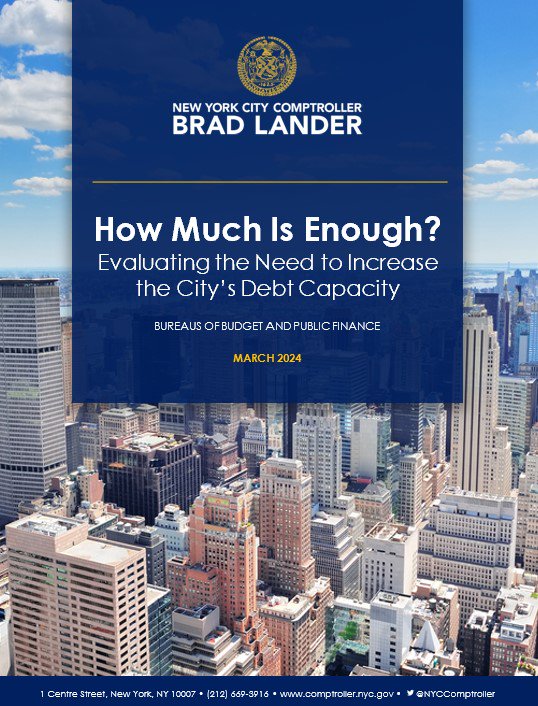Infrastructure Financing
Last updated December 1, 2023Infrastructure Financing
In FY 2023, the City entered into contracts for capital projects for a total of $16.5 billion and liquidated $11.3 billion in expenditures, but we can do better to ensure that spending is affordable, strategic, and in line with our infrastructure needs and priorities. For the Office of the NYC Comptroller, this means managing the City’s financing program efficiently with our partners at the Office of Management and Budget, forecasting the Citys’ borrowing facility carefully and assessing the affordability of debt, monitoring contracts and capital spending, setting and reviewing guidelines for project eligibility for capital spending, and maximizing Federal and other funding opportunities.

How Much Is Enough? Evaluating the Need to Increase the City’s Debt Capacity
New York City government’s statutory debt limit is set by the New York State Constitution. The City is permitted to incur indebtedness to execute its capital projects up to a maximum tied by the State Constitution to a fraction of, conceptually, the value of real estate in New York City. Given the increase in actual and planned contractual obligations for capital projects and the effect of the COVID-19 pandemic on NYC Department of Finance property tax assessments, the City’s remaining debt-incurring power is narrowing.
This report analyzes the City’s remaining debt-incurring power, the debt service impact of potential increases, and affordability metrics resulting from the additional borrowing required to fund the City’s needs.
Municipal Bonds
Unlike the City’s operating budget – funded largely through taxes and state and federal grants – the capital budget is primarily funded through a municipal bond program (mainly General Obligation, Transitional Finance Authority, and New York Municipal Water Authority bonds) that allows the City to fund capital projects and pay off their debt over time. The costs return to the operating budget as debt service payments, which are made from the City’s operating funds.
The Comptroller’s Bureau of Public Finance, in partnership with the Mayor’s Office of Management and Budget, manages the issuance of long-term, tax-exempt, and taxable municipal bonds that pay for the city’s infrastructure needs. New York City also issues bonds to refinance outstanding bonds for interest savings, which save money for taxpayers.
Managing NYC’s Debt
The Comptroller’s Office issues an annual report on December 1, Report on Capital Debt and Obligations that assesses and advises the level of debt which, in the Comptroller’s opinion, the City may legally and soundly incur for capital projects during each of the four succeeding fiscal years. The report also provides an overview of the City’s debt outstanding and measures of debt burden.
Read the Annual Report on Capital Debt and Obligations
Maximizing Federal Investment
The 2021 Infrastructure Investment and Jobs Act (IIJA) marks one of the largest infusions of federal funding into the nation’s infrastructure of the last century. The Comptroller’s Office analyzed current and projected IIJA transportation spending in New York City, and made recommendations to better align federal infrastructure funding with active transportation, climate, and safety goals to maximize the potential benefits of these much-needed resources.
New York State and New York City are set to receive at least $36 billion and $1.58 billion, respectively, in funds dedicated to transportation uses. A significant amount of the state’s funding will go to large transit projects: $6.88 billion to the Gateway Development Commission for the Hudson Tunnel Project and $2.5 billion to the MTA to extend the Second Avenue Subway to 125th Street in Harlem. But more than $3.5 billion will go to highway projects, including more than $1 billion of state-led highway expansion projects in the five boroughs.
Federal funding can be a critical resource to upgrade our roadway and transit systems to prioritize safety, accessibility, sustainability, equity, and quality of life outcomes—but only if the criteria for selecting and prioritizing projects align with those objectives.
Where do City Capital Dollars Go?
How much is the City projected to spend on infrastructure?
Source: NYC Office of Management and Budget, FY 2024 Adopted Capital Commitment Plan, September 2023
How will federal dollars be spent in New York?
New York State IIJA Funding (Millions) by Program Area and Award Type
